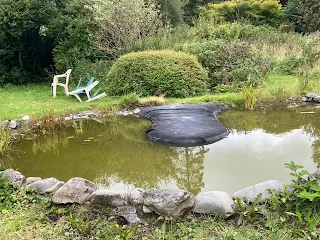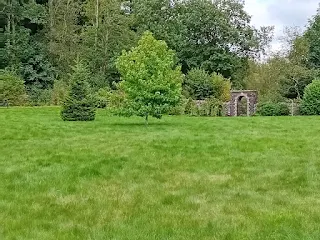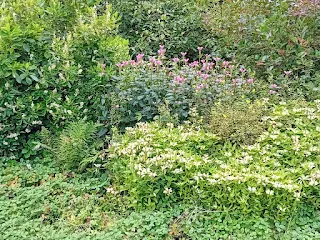 |
| Walled Garden, Hafod |
On Friday 25th August a small group of us went up to the Hafod estate, a Georgian park not far from Devil's Bridge, particularly to see the Walled Garden, and the flower gardens.
In the late 18th century, Thomas Johnes built a new house in this remote location and laid out its grounds with circuit walks, allowing the visitor to enjoy a succession of views and experiences. These have been recreated after the house was demolished and the estate forgotten. It is valued as having one of the most picturesque vistas in Europe (according to the National Trust).
This was my second visit; I'd followed the 'Weatherman Walking' trail around the 200 hectare estate some years ago. We walked the trails to find its house ruins, the still-functioning church, the secret, roaring waterfall and the spectacular viewing points, from which you can see the sleepy river Ystwyth, forests, meadows and grazing sheep.
 The two acre walled garden must have looked wonderful in its day, supplying the busy kitchen with all the food it needed, but when a group of enthusiastic vegetable gardeners, included Malcom Berry, the 'Dreaded Gardener', took it over on a five year lease, it was in dreadful decline. They have worked hard in this beautifully sunny, enclosed space, to start growing for eating again.We were greeted by Julie, who took us into one of the two large glass houses, where they had created a warm and comfy space for themselves to relax between bursts of gardening. She immediately made us all 'freshly ground coffee'. As we sipped, we asked her about the history of redeveloping the garden and she explained they were a 'Not for Profit Interest Company’. Wordy, but basically comprising six directors, with a passion and interest in gardening, but also a commitment to the financial responsibilities. "We didn't expect to be directors of anything!" she said. "But we hoped for outcomes to the project. We like to think we're promoting gardening as a healthy outdoor recreation for all ages. We want to be part of educating people so they can share these practices with their families, friends, and neighbours. We're conserving open space and wildlife habitat for the benefit of future generations and welcome children – in fact, my daughter and granddaughter will be arriving later."
The two acre walled garden must have looked wonderful in its day, supplying the busy kitchen with all the food it needed, but when a group of enthusiastic vegetable gardeners, included Malcom Berry, the 'Dreaded Gardener', took it over on a five year lease, it was in dreadful decline. They have worked hard in this beautifully sunny, enclosed space, to start growing for eating again.We were greeted by Julie, who took us into one of the two large glass houses, where they had created a warm and comfy space for themselves to relax between bursts of gardening. She immediately made us all 'freshly ground coffee'. As we sipped, we asked her about the history of redeveloping the garden and she explained they were a 'Not for Profit Interest Company’. Wordy, but basically comprising six directors, with a passion and interest in gardening, but also a commitment to the financial responsibilities. "We didn't expect to be directors of anything!" she said. "But we hoped for outcomes to the project. We like to think we're promoting gardening as a healthy outdoor recreation for all ages. We want to be part of educating people so they can share these practices with their families, friends, and neighbours. We're conserving open space and wildlife habitat for the benefit of future generations and welcome children – in fact, my daughter and granddaughter will be arriving later." "Our first setback was to discover that the soil had dangerous amounts of lead in it; above the safe limit. Which meant that any edibles that grew in the soil (like brassicas and roots) were not safe to eat. Fruits were fine; so the apple trees, as well as legumes, tomatoes, aubergines, pepper and cucumbers, could be eaten."
"Our first setback was to discover that the soil had dangerous amounts of lead in it; above the safe limit. Which meant that any edibles that grew in the soil (like brassicas and roots) were not safe to eat. Fruits were fine; so the apple trees, as well as legumes, tomatoes, aubergines, pepper and cucumbers, could be eaten." Even so, a lot of work is involved, and a team of around 6 meet regularly. They are hoping to start veg boxes soon, to supplement the grants they have received. We toured the garden. All around the edge are ancient heritage apple trees, and the group hope to do an apple pressing this autumn. Although the no-dig beds are fairly new, they are respondent with leeks, carrots, kale, and herbs. There were cries of 'wow' as we got to the large polytunnel, filled with produce and so colourful. In the centre, they are experimenting with the 'three sisters' method; that ancient South American way of planting sweet corn, encouraging runner beans up their stalks, and allowing courgettes to grow in the shade of their roots.
Even so, a lot of work is involved, and a team of around 6 meet regularly. They are hoping to start veg boxes soon, to supplement the grants they have received. We toured the garden. All around the edge are ancient heritage apple trees, and the group hope to do an apple pressing this autumn. Although the no-dig beds are fairly new, they are respondent with leeks, carrots, kale, and herbs. There were cries of 'wow' as we got to the large polytunnel, filled with produce and so colourful. In the centre, they are experimenting with the 'three sisters' method; that ancient South American way of planting sweet corn, encouraging runner beans up their stalks, and allowing courgettes to grow in the shade of their roots.The pond has been dug and created by Malcom, and is already attracting wildlife. "The pond is going be central to our sustainable thinking in the walled garden," Julie explained. "He's planted lilies and marginal plants. Already, there are water boatmen all over it in summer."
Mrs Johnes' Flower Garden was begun in the 18th Century to feature plants from the Americas. By the 1930s, it was overgrown, and in the 1950s it was further damaged by forestry activity. It has the most wonderful perimeter stone walls, which have been restored.The garden looks peaceful, and it is clear that it is being restored carefully, with some interesting planting.
We then followed a tiny walkers' path up and up to a spectacular viewpoint.This is where we found Marianne Johnes ' garden. It is a walled garden on a south-facing precipice – a secret retreat and botanical space. No original plantings survive, although later exotic plants include ginkgo, yellow buck-eye and hiba, and now it is filled with heather and ferns. Early in its history, it included a moss house and an ornamental urn by Thomas Banks, inscribed with sentimental verse by Samuel Rogers.
' garden. It is a walled garden on a south-facing precipice – a secret retreat and botanical space. No original plantings survive, although later exotic plants include ginkgo, yellow buck-eye and hiba, and now it is filled with heather and ferns. Early in its history, it included a moss house and an ornamental urn by Thomas Banks, inscribed with sentimental verse by Samuel Rogers.
We were quite pooped by the time we reached these dizzy heights, and the pretty white bench was perfect for a quick recovery.
You can see what the gardeners at the walled garden have been doing by going to their Facebook Page, which shows the spectacular harvest and the things they have for sale. Go to https://www.facebook.com/HafodWGG





